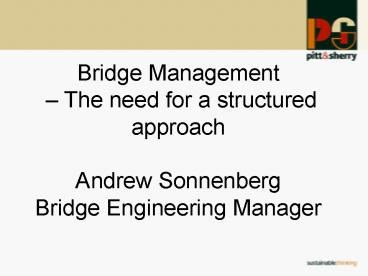Bridge Management The need for a structured approach Andrew Sonnenberg Bridge Engineering Manager - PowerPoint PPT Presentation
1 / 26
Title:
Bridge Management The need for a structured approach Andrew Sonnenberg Bridge Engineering Manager
Description:
Managing Local Government bridges using Bridge Management Plans. Level 1 ,2 ... Key components of a Bridge ... on long roads and for bridges in parkland. ... – PowerPoint PPT presentation
Number of Views:124
Avg rating:3.0/5.0
Title: Bridge Management The need for a structured approach Andrew Sonnenberg Bridge Engineering Manager
1
Bridge Management The need for a structured
approachAndrew SonnenbergBridge Engineering
Manager
2
Overview
- Managing Local Government bridges using Bridge
Management Plans - Level 1 ,2 and 3 inspections
- Prioritising works
- Benefits of a structured approach
3
Bridge Management Plans
- Key components of a Bridge Management Plan.
- Consistent with IPWEA International
Infrastructure Management Manual.
4
Bridge Management Plans
5
Inventory
- Asset No. do not change once the number is
assigned. - Location - GPS coordinates so that the structures
can be readily found. Especially important on
long roads and for bridges in parkland. - Dimensions for asset valuation and load
assessment. - Components for condition monitoring
- Materials timber bridges typically are less
durable.
6
Inventory
- Load rating what vehicles can run on a bridge
and how much reserve there is. Can HML vehicles
run, fire trucks and garbage trucks. - Design drawings enable bridge upgrades to occur
efficiently and load rating. May have
geotechnical data. - Owner indentify bridges with joint ownership or
ownership by other authorities. - Heritage information
7
Condition assessment
8
VicRoads Bridge Inspection Manual
9
Condition assessment
- Level 1 inspections 6 monthly
- Inspectors shall have extensive practical
experience in road and bridge routine maintenance - Vandalism
- Accident, flood and fire damage
- Obvious distress
- Doesnt currently include photos
- Not currently component based.
10
Condition assessment
11
Condition assessment
- Level 2 inspections
- For collecting generic data
- For collecting condition data
- Photos individually named in a meaningful way
- Link defect photos to specific defects.
- Note status of repair works and changes in
defects overtime
12
Condition assessment
13
Condition assessment
14
Condition assessment
15
Bridge Management Plans
- Record deterioration of defects over time
- Close out repair works
- Track costs
16
Bridge Management Plans
17
Load Rating
- Level 3 inspections
- Minimum of 5 year experience with current bridge
design and construction experience - Prequalified with VicRoads
- NDT
- Determine load rating
- Assess the effect of defects
- Investigate strengthening solutions
18
Load Rating
The general equation to determine the rating
factor (RF) for bridges is
19
Bridge Management Plans
20
Historical Recording
- Record deterioration of defects over time
- Close out repair works
- Track costs
- Show that the money spent has been worthwhile.
- Estimate decline in value over time
21
Bridge Management System
- Bridge Management System with access for
- Inspectors
- Asset manager
- Maintenance personnel
- Handle work flows
22
Bridge Management Plans
- Determine relative risk of structures and defects
- Important that the methodology is clear defined
23
Risk Assessment
24
Bridge Management Plans
- Compare structure condition and risk against
intervention criteria
25
Bridge Management Plans
- Schedule maintenance and capital works based on
risk - Particularly important for barrier upgrades and
strengthening works
26
Benefits of structured approach
- Consistency of results overtime even with changes
in staff at Council. - Justify that the money being spent is spent in
the most appropriate way. - Obtain funding for works to ensure the
sustainability of the infrastructure. - Identify when works must be done or load limits
placed. - Clearly specify the skills required for those who
undertake works to ensure data collected is
accurate.

